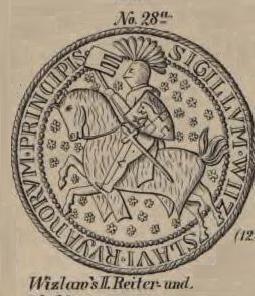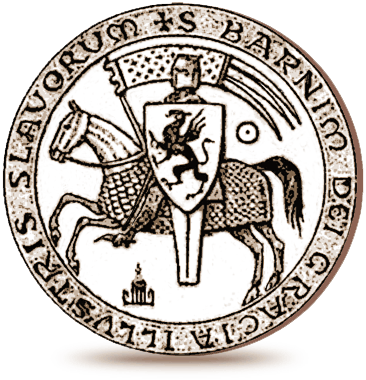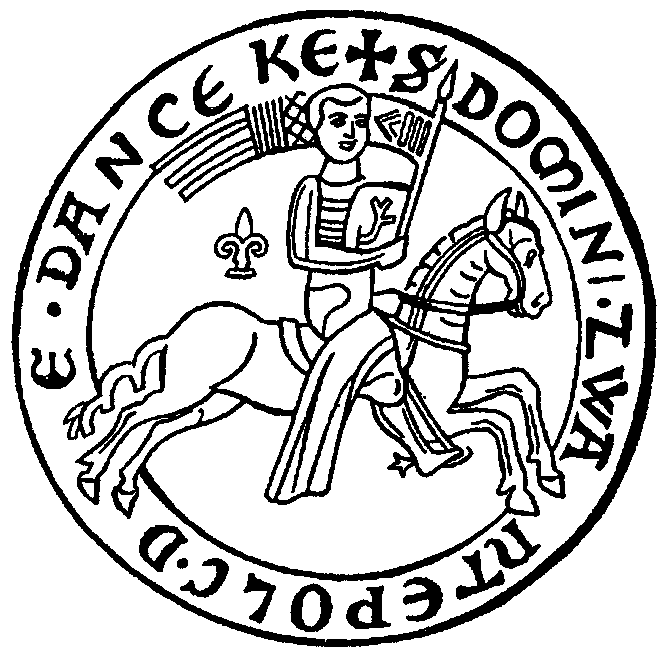|
Civil War In Pomerelia
The civil war in Pomerelia was a military conflict in Pomerelia fought from 1269 to 1272. The conflict began between members of the Samboride dynasty, with Mestwin II, ruler of the Duchy of Świecie fighting against Wartislaw II of Gdańsk, ruler of the Duchy of Gdańsk, and Sambor II, ruler of the Duchy of Lubiszewo. In 1270, Mestwin had conquered their states, unifying the Duchy of Pomerelia under his rule. Wartislaw II and Sambor II continued to fight from exile, aided by the Duchy of Inowrocław and the State of the Teutonic Order, while Mestwin had allied with Bolesław the Pious, ruler of the Duchy of Greater Poland. In 1271, the war was joined by the Margraviate of Brandenburg who attempted to conquer the Duchy of Pomerelia. The war ended in January 1272, with Mestwin II's victory, establishment of the Duchy of Pomerelia, and partition of the Duchy of Inowrocław between Pomerelia and Greater Poland. Background On 10 January 1266, Swietopelk II, the ruler of the ... [...More Info...] [...Related Items...] OR: [Wikipedia] [Google] [Baidu] |
Pomerelia
Pomerelia,, la, Pomerellia, Pomerania, pl, Pomerelia (rarely used) also known as Eastern Pomerania,, csb, Pòrénkòwô Pòmòrskô Vistula Pomerania, prior to World War II also known as Polish Pomerania, is a historical sub-region of Pomerania on the southern shore of the Baltic Sea. The designation of Gdańsk Pomerania, is largely coextensive with Pomerelia, but slightly narrower, as it does not cover the Chełmno Land (including the Michałów Land). Its largest and most important city is Gdańsk. Since 1999, the region has formed the core of the Pomeranian Voivodeship. Overview Pomerelia is located in northern Poland west of the Vistula river and east of the Łeba river, mostly within the Pomeranian Voivodeship, with southern part located in the Kuyavian-Pomeranian Voivodeship and small parts in West Pomeranian Voivodeship. It has traditionally been divided into Kashubia, Kociewie, Tuchola Forest and Chełmno Land (including the Michałów Land, sometimes with the add ... [...More Info...] [...Related Items...] OR: [Wikipedia] [Google] [Baidu] |
Conrad, Margrave Of Brandenburg-Stendal
Margrave Conrad I of Brandenburg ( – 1304) was a member of the House of Ascania and a co-ruler of Brandenburg. Life Conrad I was the fourth of six children of Margrave John I of Brandenburg and his wife Sophia, daughter of King Valdemar II of Denmark. He was 26 years old when, in 1266, his father died and he and his elder brothers John II and Otto IV became co-rulers of Brandenburg. Conrad went on to rule in the newly acquired Neumark part of Brandenburg east of the Oder River, though he rarely appeared on the political scene. On one occasion, he assisted his brother Otto IV, when they allied with Duke Mestwin II of Pomerelia according to the 1269 Treaty of Arnswalde, occupying the Pomerelian city of Gdańsk and gaining the Pomeranian territory around Rügenwalde. He died in 1304 and was buried beside his wife in Chorin Abbey. There is an entry in the register at Chorin as follows: Marriage and issue Conrad was married to Constance of Poznań (d. 1281), daught ... [...More Info...] [...Related Items...] OR: [Wikipedia] [Google] [Baidu] |
Principality Of Rügen
The Principality of Rügen; da, Fyrstendømmet Rygien; pl, Księstwo rugijskie; la, Rugia was a Danish principality, formerly a duchy, consisting of the island of Rügen and the adjacent mainland from 1168 until 1325. It was governed by a local dynasty of princes of the ''Wizlawiden'' (''House of Wizlaw'') dynasty. For at least part of this period, Rügen was subject to the Holy Roman Empire. Danish conquest and conversion The Danes conquered the Rani stronghold of Arkona in 1168. The rulers of the Rani became vassals of the Danish king, and the Slavic population was gradually Christianized. In the 12th century, the Duchy of Rügen not only functioned as a bridgehead for Danish expansions into ''Vendland'', but also Rani forces successfully participated in Danish raids into Circipania and areas conquered by Pomerania's Wartislaw I in the 1120s. After Pomerania became part of the Holy Roman Empire in 1181, it sent out a navy in 1184 to subdue Rügen for the empire, too. ... [...More Info...] [...Related Items...] OR: [Wikipedia] [Google] [Baidu] |
Vitslav II, Prince Of Rügen
Vitslav II (c. 1240 – 1302), variously called Vislav, Vizlav, Wislaw, Wizlaw and Witslaw in English sources (german: Wizlaw II) was a prince of Rügen.Vitslav is the most common variant and also the closest in sound to the German ''Wizlaw''. Life Vitslav was probably born between 1240 and 1245 as the son of Prince Jaromar II of Rügen and Euphemia, a daughter of Duke Swantopolk II of East Pomerania. After his father, who had taken part on the side of the church in battles in Denmark between the Danish royal house and the Archbishopric of Lund. When his father was stabbed to death by a woman in 1260 out of revenge, Vitslav became the reigning Prince of Rügen. From the beginning of his reign Vitslav II maintained good relations with the Hanseatic town of Lübeck, whose merchants he exempted from customs duties within his principality and with whom, in 1266, he renewed the existing trade agreements. In 1269, he supported the town of Stralsund, located within his territory, by ... [...More Info...] [...Related Items...] OR: [Wikipedia] [Google] [Baidu] |
Duchy Of Pomerania
The Duchy of Pomerania (german: Herzogtum Pommern; pl, Księstwo Pomorskie; Latin: ''Ducatus Pomeraniae'') was a duchy in Pomerania on the southern coast of the Baltic Sea, ruled by dukes of the House of Pomerania (''Griffins''). The country had existed in the Middle Ages, in years 1121–1160, 1264–1295, 1478–1531 and 1625–1637. The duchy originated from the realm of Wartislaw I, a Slavic Pomeranian duke, and was extended by the Lands of Schlawe and Stolp in 1317, the Principality of Rügen in 1325, and the Lauenburg and Bütow Land in 1455. During the High Middle Ages, it also comprised the northern Neumark and Uckermark areas as well as Circipania and Mecklenburg-Strelitz. The Duchy of Pomerania was established as a vassal state of Poland in 1121, which it remained until the fragmentation of Poland after the death of Polish ruler Bolesław III Wrymouth in 1138. Afterwards the Dukes of Pomerania were independent, and later were vassals of the Duchy of Saxony from 1164 ... [...More Info...] [...Related Items...] OR: [Wikipedia] [Google] [Baidu] |
Barnim I, Duke Of Pomerania
Barnim I the Good ( – 13 November 1278) from the Griffin dynasty was a Duke of Pomerania (''ducis Slauorum et Cassubie'') from 1220 until his death. Life Son of Duke Bogislaw II and Miroslava of Pomerelia, he succeeded to the Duchy of Pomerania-Stettin upon his father's death in 1220; he had however to share the rule of Pomerania with his cousin Wartislaw III, who resided at Demmin. Because he was minor when his father died, until about 1226 his lands were under the regency of his mother Miroslawa from the Pomerelian Samborides dynasty. At first still a Danish fief, the Pomeranian lands fell back to the Holy Roman Empire after the victory of several North-German princes at the 1227 Battle of Bornhöved. Emperor Frederick II of Hohenstufen in 1231 put the Duchy of Pomerania under the suzerainty of the Ascanian margraves of Brandenburg, disregarding the tenure of the Griffin dynasty, and thereby fueling the long-term Brandenburg–Pomeranian conflict. After his cousin Wartisla ... [...More Info...] [...Related Items...] OR: [Wikipedia] [Google] [Baidu] |
Ratibor Of Białogarda
Ratibor of Białogarda; csb, Ratibór biôłogardzczi ( – 6 June 1272) was a duke from the Samboride dynasty. From 1233 until 1262, he was a duke of the Duchy of Białogarda.Labuda Gerard, ''Mściwoj I, Słownik biograficzny Pomorza Nadwiślańskiego'', vol. 3.Józef Wójcicki, ''Dzieje Polski nad Bałtykiem''. p. 39. In 1262, he became the knight of the Teutonic Order, giving his lands to it. History Racibor was born around 1212. He came from the Samboride dynasty and was a son of Mestwin I and Zwinisława, and the brother of Swietopelk II, Warcisław I and Sambor II. After the death of his father in 1219 or 1220, Swietopelk II took care of Racibor, Warcisław and Sambor II until they reached the ages of 20. Upon that, Racibor had been titled the duke of Białogarda, receiving his duchy, that was formed from the partition of the Duchy of Świecie and Lubiszewo. Białogarda had become the capital of the country. In 1237, persuaded by Sambor II, duke of Lubiszewo, Racibor ha ... [...More Info...] [...Related Items...] OR: [Wikipedia] [Google] [Baidu] |
Duchy Of Białogarda
Duchy of Białogarda was a duchy in the Pomerelia centred around its capital, Białogarda. It was formed in 1233 from the partition of the Duchy of Świecie and Lubiszewo,Labuda Gerard, ''Mściwoj I, Słownik biograficzny Pomorza Nadwiślańskiego'', vol. 3.Józef Wójcicki, ''Dzieje Polski nad Bałtykiem''. p. 39. and existed until 1262 when it was incorporated into the State of the Teutonic Order. Its only ruler was duke Racibor of Białogarda of the Samborides, Samboride dynasty. History The state was formed from the partition of the Duchy of Świecie and Lubiszewo, with Racibor of Białogarda being made its duke by his older brother, Swietopelk II, Duke of Pomerania, Swietopelk II, duke of Gdańsk. Białogarda had become the capital of the country. In 1237, persuaded by his brother, duke Sambor II, Duke of Pomerania, Sambor II, duke of Lubiszewo, Racibor had invaded Pomerania-Schlawe. Alternatively, according to some historians, he could be Ratibor II, Duke of Pomerania, Rat ... [...More Info...] [...Related Items...] OR: [Wikipedia] [Google] [Baidu] |
Białogarda
Białogarda (; csb, Biôłogarda, german: Belgard an der Leba) is a village in the administrative district of Gmina Wicko, within Lębork County, Pomeranian Voivodeship, in northern Poland. It is situated east of the Łeba river in the historic Pomerelian region, approximately south-east of Wicko, north-west of Lębork, and north-west of the regional capital Gdańsk. The village has a population of 223. History Białogarda is one of the oldest documented settlements of the region, mentioned in a 1209 deed, after Duke Sambor I of Pomerania had granted the castellany near the border with the Pomeranian Lands of Schlawe and Stolp to his younger brother Mestwin I. Mestwin's son, the Pomerelian duke Ratibor (''Racibor Białogardzki''), made Białogarda his residence between 1233 and 1262. After Ratibor had invaded the adjacent Stolpe Land, then held by his elder brother Duke Swietopelk II, his castle was devastated in the following fratricidal war within the ruling Samborides ... [...More Info...] [...Related Items...] OR: [Wikipedia] [Google] [Baidu] |
Gdańsk
Gdańsk ( , also ; ; csb, Gduńsk;Stefan Ramułt, ''Słownik języka pomorskiego, czyli kaszubskiego'', Kraków 1893, Gdańsk 2003, ISBN 83-87408-64-6. , Johann Georg Theodor Grässe, ''Orbis latinus oder Verzeichniss der lateinischen Benennungen der bekanntesten Städte etc., Meere, Seen, Berge und Flüsse in allen Theilen der Erde nebst einem deutsch-lateinischen Register derselben''. T. Ein Supplement zu jedem lateinischen und geographischen Wörterbuche. Dresden: G. Schönfeld’s Buchhandlung (C. A. Werner), 1861, p. 71, 237.); Stefan Ramułt, ''Słownik języka pomorskiego, czyli kaszubskiego'', Kraków 1893, Gdańsk 2003, ISBN 83-87408-64-6. * , )Johann Georg Theodor Grässe, ''Orbis latinus oder Verzeichniss der lateinischen Benennungen der bekanntesten Städte etc., Meere, Seen, Berge und Flüsse in allen Theilen der Erde nebst einem deutsch-lateinischen Register derselben''. T. Ein Supplement zu jedem lateinischen und geographischen Wörterbuche. Dresden: G. Schönf ... [...More Info...] [...Related Items...] OR: [Wikipedia] [Google] [Baidu] |
Swietopelk II, Duke Of Pomerania
Swietopelk II, also Zwantepolc II or Swantopolk II, (1190/1200 – 11 January 1266), sometimes known as the Great ( pl, Świętopełk II Wielki; Kashubian: ''Swiãtopôłk II Wiôldżi''), was the ruling Duke of Pomerelia-Gdańsk from 1215 until his death. He was the first member of the Samborides to style himself ''dux'' from 1227 onwards.Loew PO: Danzig. Biographie einer Stadt, Munich 2011, p. 32: "Sambor ..styled himself 'princeps Pomoranorum,' .. but not 'dux,' which was the privilege of the Piasts." p. 33: "After Sambor's death ..his brother Mestwin ..strove after gaining ever greater independence from Poland. He confidently styled himself 'princeps in Danzk' and expanded southwards. His oldest son Swantopolk (Swietopelk), ruling from 1217 onwards, exploited Poland's fragmentation to acquire independence for his realm; already since 1227 he styled himself 'dux,' 'Duke of Pomerelia.'" Names The duke is known under many spellings (''Swantepolk, Swantipolk, Svatopluk, S ... [...More Info...] [...Related Items...] OR: [Wikipedia] [Google] [Baidu] |
Samborides
The Samborides () or House of Sobiesław () were a ruling dynasty in the historic region of Pomerelia. They were first documented about 1155 as governors (''princeps'') in the Eastern Pomeranian lands serving the royal Piast dynasty of Poland, and from 1227 ruled as autonomous princes until 1294, at which time the dynasty died out. The subsequent war for succession between the Polish Piast dynasty, the Imperial Margraviate of Brandenburg and the State of the Teutonic Order resulted in the Teutonic takeover of Gdańsk (Danzig) in 1308. Geography The dynasty's dominion, Pomerelia, roughly corresponded with the area of today's Pomeranian Voivodeship in northern Poland. The Samborides from 1227 used the Medieval Latin title ''dux Pomeraniae''; their Duchy of Pomerelia was therefore referred to as "Duchy of Pomerania", even though there was another Duchy of Pomerania to the west, ruled by the House of Griffins, who likewise bore the title "Dukes of Pomerania". In Polish usage, the ... [...More Info...] [...Related Items...] OR: [Wikipedia] [Google] [Baidu] |


.jpeg/1200px-Brama_Zuraw_W_Gdansku_(153003103).jpeg)
